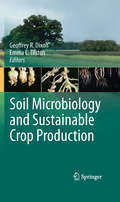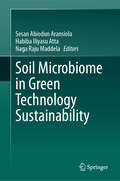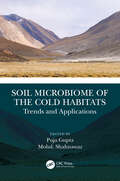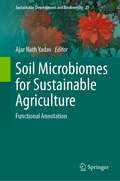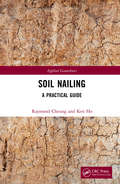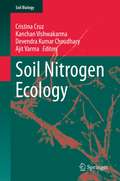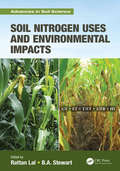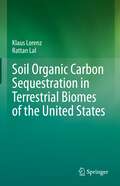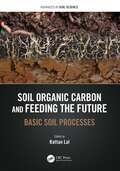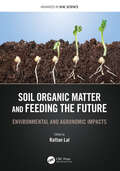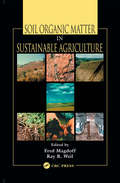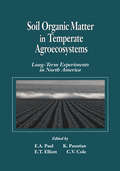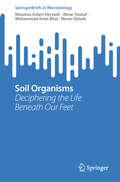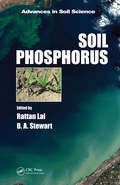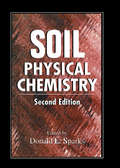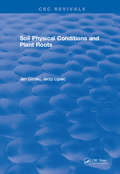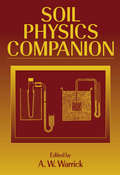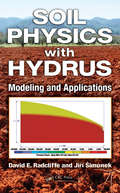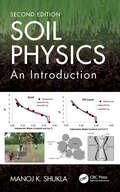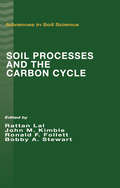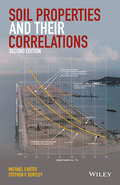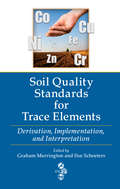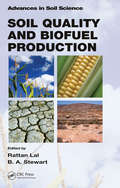- Table View
- List View
Soil Microbiology and Sustainable Crop Production
by Geoffrey R. Dixon Emma L. TilstonSoils into which crop plants root and from which they obtain essential minerals and water contain huge arrays of microbes. Many have highly beneficial effects on crop growth and productivity, others are pathogens causing diseases and losses to yield and quality, a few microbes offer protection from these pathogenic forms and others have little or no effect. These intimate and often complex inter-relationships are being explored with increasing success providing exciting opportunities for increasing crop yields and quality in sustainable harmony with the populations of beneficial soil microbes and to the detriment of pathogens. This book explores current knowledge for each of these aspects of soil microbiology and indicates where future progress is most likely to aid in increasing crop productivity by means which are environmentally benign and beneficial.
Soil Microbiome in Green Technology Sustainability
by Naga Raju Maddela Sesan Abiodun Aransiola Habiba Iliyasu AttaThis book addresses sustainable solutions to problems in various environments using microorganisms dwelling in the soil and sustainable approaches applicable now and in the future. It focuses on the role of the soil microbiome—a rich community of beneficial bacteria and fungi—in green technology for a safe environment. This volume delves into the dynamics between the soil ecosystem and microorganisms; their interrelationships; and man’s role in maintaining soil health and quality. The chapters cover topics such as pollution control, enhancing soil fertility, climate change mitigation, biocontrol of pathogens, and nanotechnology applications. The authors provide an expert analysis of how these microbial communities contribute to green technological sustainability. Readers will find contributions by renowned scholars who explore these themes through empirical research and practical case studies. The book highlights how these microorganisms can be major players in nature-based solutions while shifting perceptions from harmful to beneficial roles. Soil Microbiome in Green Technology Sustainability is essential reading for researchers, scholars, practitioners, students at all levels, and anyone interested in environmental science or biotechnology. It offers valuable insights into using microbial capabilities for sustainable development across various industrial sectors. This volume is particularly relevant for those involved in renewable energy, recycling, carbon capturing, storage technologies, or any field seeking eco-friendly solutions to global challenges.
Soil Microbiome of the Cold Habitats: Trends and Applications
by Puja Gupta and Mohd. ShahnawazThis book focuses on cold habitat microbes as a potential source of elite enzymes and secondary metabolites to meet the growing demands of the pharmaceutical, food and biotechnological industries. Microbes living in such extremely cold conditions are reported to produce various biomolecules with potential biotechnological applications. The book overviews recent research trends to discover such important biomolecules and also suggests future research directions to discover such elite novel biomolecules. Salient features: Covers studies on various biotic communities and abiotic components of the soil of terrestrial habitats with a focus on cold habitats Discusses various 'Omic' approaches: metagenomics and meta-transcriptomics Lists adaptation strategies adopted by cold-adapted microbes Highlights various biotechnological and industrially important biomolecules produced by cold-adapted microbes Explores the role of microbial biofilm in the degradation of microplastics in cold habitats
Soil Microbiomes for Sustainable Agriculture: Functional Annotation (Sustainable Development and Biodiversity #27)
by Ajar Nath YadavThis book encompasses current knowledge of soil microbiomes and their potential biotechnological application for plant growth, crop yield, and soil health under the natural as well as harsh environmental conditions for sustainable agriculture. The microbes are ubiquitous in nature. The soil is a natural hotspot of the soil microbiome. The soil microbiome plays a critical role in the maintenance of global nutrient balance and ecosystem functioning. The soil microbiomes are associated with plant ecosystems through the intense network of plant–microbe interactions. The microbes present in bulk soil move toward the rhizospheric region due to the release of different nutrients by plant systems. The rhizospheric microbes may survive or proliferate in rhizospheric zone depending on the extent of influences of the chemicals secreted into the soil by roots. The root exudates contain the principal nutrients factors (amino acids, glucose, fructose, and sucrose). The microbes present in rhizospheric region have capabilities to fix atmospheric nitrogen, produce different phytohormones, and solubilize phosphorus, potassium, and zinc. The plant systems take these nutrients for their growth and developments. These soil and plant associated microbes also play an important role in protection of plants from different plant pathogenic organisms by producing different secondary metabolites such as ammonia, hydrogen cyanide, siderophores, and hydrolytic enzymes. The soil microbiomes with plant growth-promoting (PGP) attributes have emerged as an important and promising tool for sustainable agriculture. The soil microbiomes promote the plant growth and enhance the crop yield and soil fertility via directly or indirectly different plant growth-promoting mechanism. The soil microbes help the plant for adaptation in extreme habitats by mitigating the abiotic stress of high/low temperatures, hypersalinity, drought, and acidic/alkaline soil. These PGP microbes are used as biofertilizers/bioinoculants to replace the harmful chemical fertilizers for sustainable agriculture and environments.The aim of the book “Soil Microbiomes for Sustainable Agriculture” is to provide the recent advances in mechanisms of plant growth promotion and applications of soil microbiomes for mitigation of different abiotic stresses in plants. The book is useful to scientists, researchers, and students related to microbiology, biotechnology, agriculture, molecular biology, environmental biology, and related subjects.
Soil Nailing: A Practical Guide
by Ken Ho Raymond CheungSoil nailing is an in situ soil reinforcement technique that can be used to enhance the stability of slopes, retaining walls, embankments, and excavations. It involves installation of closely spaced, relatively slender unstressed tension-carrying structural elements into the ground to stabilize the soil mass. These elements, which are called soil nails, comprise steel or other engineering materials such as fiber reinforced polymer. Soil nailing did not gain popularity until the 1970s when engineers started to realize that the technique could offer an effective, robust, and economical reinforcing system for a variety of ground conditions. More importantly, the track record has been excellent in that no major collapses have been reported in properly designed and well-constructed soil nailed structures so far. Considerable experience and knowledge of the technique have been gained in the past few decades through systematic technical development work comprising laboratory tests, numerical modeling, physical modeling, site trials and field monitoring covering design, and construction practices. Soil Nailing: A Practical Guide consolidates the experience and advances made in the development and use of the soil nailing technique and encourages a wider adoption of the technique by practitioners. The book is intended for use by postgraduate students, researchers, and practicing civil and geotechnical engineers, who wish to have a more in-depth and fundamental understanding of the theory and practice behind the technique. It presents the basic principles of the technique as well as state-of-the-art knowledge and recommended standard of good practice in respect of design, construction, monitoring, and maintenance of soil nailed structures.
Soil Nitrogen Ecology (Soil Biology #62)
by Ajit Varma Devendra Kumar Choudhary Cristina Cruz Kanchan VishwakarmaThis book highlights the latest discoveries about the nitrogen cycle in the soil. It introduces the concept of nitrogen fixation and covers important aspects of nitrogen in soil and ecology such as its distribution and occurrence, soil microflora and fauna and their role in N-fixation. The importance of plant growth-promoting microbes for a sustainable agriculture, e.g. arbuscular mycorrhizae in N-fixation, is discussed as well as perspectives of metagenomics, microbe-plant signal transduction in N-ecology and related aspects. This book enables the reader to bridge the main gaps in knowledge and carefully presents perspectives on the ecology of biotransformations of nitrogen in soil.
Soil Nitrogen Uses and Environmental Impacts (Advances in Soil Science)
by Rattan Lal B. A. StewartNitrogen (N) is potentially one of the most complex elements on the Earth. It is necessary for all biological activity, but creates negative impacts on water and air quality. There is a balancing act between deficiency and surplus and the forms of N available further complicate our understanding of the dynamics. Biological fixation provides some plants with N supply while others are totally dependent upon N being available in the soil profile for the roots to extract. Nevertheless, the demand for N will increase because the human population with its increasing growth requires more protein and thus more N. Understanding the global N cycle is imperative to meeting current and future nitrogen demands while decreasing environmental impacts. This book discusses availability, production, and recycling of N in air, water, plants, and soils. It features information on N impacts to soil and water quality, management of N in agroecosystems, and techniques to maximize the use efficiency while minimizing the risks of leakage of reactive N into the environment. This volume in the Advances in Soil Science series is specifically devoted to availability, production, and recycling of N with impact on climate change and water quality, and management of N in agroecosystems in the context of maximizing the use efficiency and minimizing the risks of leakage of reactive N (NO-3, N¬2O) into the environment.
Soil Organic Carbon Sequestration in Terrestrial Biomes of the United States
by Klaus Lorenz Rattan LalThis book collates, reviews and synthesizes information on how soil organic carbon (SOC) stocks differ among major terrestrial biomes of the U.S.A. Information on soil inorganic carbon (SIC) stocks for different terrestrial biomes of the U.S.A. will also be presented. The book deliberates options for increasing SOC stocks and enhancing SOC sequestration in terrestrial biomes by soil and land-use management practices. It concludes with an overview of terrestrial biomes of the U.S.A. where targeted soil and land-use management practices may result in the greatest increases in SOC stocks and enhancements in SOC sequestration.
Soil Organic Carbon and Feeding the Future: Basic Soil Processes (Advances in Soil Science)
by Rattan LalSoil organic matter (SOM) is a highly reactive constituent of the soil matrix because of its large surface area, high ion exchange capacity, enormous affinity for water due to hygroscopicity, and capacity to form organo-mineral complexes. It is an important source and sink of atmospheric CO2 and other greenhouse gases depending on climate, land use, soil and crop management, and a wide range of abiotic and biotic factors, including the human dimensions of socioeconomic and political factors. Agroecosystems are among important controls of the global carbon cycle with a strong impact on anthropogenic or abrupt climate change. This volume of Advances in Soil Sciences explains pedological processes set-in-motion by increases in SOM content of depleted and degraded soils. It discusses the relationship between SOM content and critical soil quality parameters including aggregation, water retention and transport, aeration and gaseous exchange, and chemical composition of soil air. The book identifies policy options needed to translate science into action for making sustainable management of SOM as a strategy for adaptation to and mitigation of climate change. Features: Relates soil organic matter stock to soil processes, climate parameters, vegetation, landscape attributes Establishes relationships between soil organic matter and land use, species, and climate Identifies land use systems for protecting and restoring soil organic matter stock Links soil organic matter stock with the global carbon cycle for mitigation of climate change Part of the Advances in Soil Sciences series, this volume will appeal to agricultural, environmental, and soil scientists demonstrating the link between soil organic matter stock and provisioning of critical ecosystem services for nature and humans.
Soil Organic Matter and Feeding the Future: Environmental and Agronomic Impacts (Advances in Soil Science)
by Rattan LalSoil organic matter (SOM) is the primary determinant of soil functionality. Soil organic carbon (SOC) accounts for 50% of the SOM content, accompanied by nitrogen, phosphorus, and a range of macro and micro elements. As a dynamic component, SOM is a source of numerous ecosystem services critical to human well-being and nature conservancy. Important among these goods and services generated by SOM include moderation of climate as a source or sink of atmospheric CO2 and other greenhouse gases, storage and purification of water, a source of energy and habitat for biota (macro, meso, and micro-organisms), a medium for plant growth, cycling of elements (N, P, S, etc.), and generation of net primary productivity (NPP). The quality and quantity of NPP has direct impacts on the food and nutritional security of the growing and increasingly affluent human population. Soils of agroecosystems are depleted of their SOC reserves in comparison with those of natural ecosystems. The magnitude of depletion depends on land use and the type and severity of degradation. Soils prone to accelerated erosion can be strongly depleted of their SOC reserves, especially those in the surface layer. Therefore, conservation through restorative land use and adoption of recommended management practices to create a positive soil-ecosystem carbon budget can increase carbon stock and soil health. This volume of Advances in Soil Sciences aims to accomplish the following: Present impacts of land use and soil management on SOC dynamics Discuss effects of SOC levels on agronomic productivity and use efficiency of inputs Detail potential of soil management on the rate and cumulative amount of carbon sequestration in relation to land use and soil/crop management Deliberate the cause-effect relationship between SOC content and provisioning of some ecosystem services Relate soil organic carbon stock to soil properties and processes Establish the relationship between soil organic carbon stock with land and climate Identify controls of making soil organic carbon stock as a source or sink of CO2 Connect soil organic carbon and carbon sequestration for climate mitigation and adaptation
Soil Organic Matter in Sustainable Agriculture (Advances In Agroecology Ser.)
by Fred Magdoff Ray R. WeilRecognition of the importance of soil organic matter (SOM) in soil health and quality is a major part of fostering a holistic, preventive approach to agricultural management. Students in agronomy, horticulture, and soil science need a textbook that emphasizes strategies for using SOM management in the prevention of chemical, biological, and physic
Soil Organic Matter in Temperate AgroecosystemsLong Term Experiments in North America
by Eldor A. Paul Keith H. Paustian E. T. Elliott C. Vernon ColeThe presence - or absence - of soil organic matter (SOM) has important implications for agricultural productivity. It could also have significant implications for global climate due to its role as a source/sink of carbon. Therefore, it is important to understand the issues related to the accumulation or loss of SOM, to use what we have learned from experiments to make sound decisions about soil and crop management, and to test models and future concepts concerning SOM management. A database is included with the book, presenting tabular data for 34 sites in North America. Soil Organic Matter in Temperate Agroecosystems discusses all of these issues and more, answering such questions as:
Soil Organisms: Deciphering the Life Beneath Our Feet (SpringerBriefs in Microbiology)
by Munir Ozturk Abrar Yousuf Moonisa Aslam Dervash Mohammad Amin BhatSoil biota is an important and fundamental part of terrestrial ecology. The soil organisms include all those life forms which pass significant proportion of their life within a soil profile. The range of organisms may vary from microscopic entities to a macro level organisms. These organisms are the hidden beauties which take up the task of food chain regulation, organic matter decomposition, and nutrient enrichment of soil. Soil organisms can be grouped into three classes viz; chemical engineers (bacteria,fungi and protozoans), biological regulators (small soil invertebrates like nematodes and mesofauna) and ecosystem engineers (large soil invertebrates and small mammals). These creatures are mainly regulated by certain physical and biological factors. The physicochemical characteristics of soil can determine its biological diversity which influences the regulatory services in an ecosystem. This book showcases the mechanisms of biological dynamics at micro, meso and macro scales of the soil organisms. The introductory chapters of this book focus on understanding the faunistic diversity and its significance in soil, bioindicators in assessment of soil quality, consequences of various stressors on soil, highlighting the eves and odds associated with agricultural industry vis-à-vis environmental pollution and the possible influences on soil biota. Remaining chapters focus on the fungal internet, ecosystem cybernetics, and the potential remedial technologies for soil conservation, and novel remediation strategies to deal with degraded soils.
Soil Phosphorus (Advances in Soil Science)
by Rattan Lal B. A. StewartPhosphorus is an essential plant nutrient, but global population growth has dramatically reduced the availability of phosphorus fertilizer resources. Despite this scarcity, there remain numerous problems associated with the excessive and inappropriate use of phosphorus leading to non-point source pollution and eutrophication of natural waters. Identifying appropriate systems for managing soil phosphorus and reducing the risks of eutrophication are needed to minimize the environmental risks. This book focuses on the availability and recycling of phosphorus; regulatory and policy issues of sustainable phosphorus use; and water quality management in agroecosystems pertaining to phosphorus. Sections are dedicated to global phosphorus reserves; cycling and pathways of phosphorus; phosphorus in agriculture; human dimensions and policy intervention; and research and development priorities. Phosphorus is a finite but crucial resource and is an essential element to all life. Sub-optimal availability and nutrient imbalance in the root zone can adversely impact plant growth, and the quality of food and feed grown on these soils. However, the proven reserves of phosphorus can hardly be adequate for a few centuries only. Yet, its misuse and mismanagement has caused severe problems of eutrophication of water and pollution of the environment. Thus, judicious management of soil phosphorus is essential. This volume is specifically devoted to availability and recycling of phosphorus, regulatory/policy issues of sustainable use of phosphorus, and management in agroecosystems in the context of maximizing the use efficiency and minimizing the environmental risks of water quality.
Soil Physical Chemistry
by Donald L. SparksSoil Physical Chemistry, Second Edition takes up where the last edition left off. With comprehensive and contemporary discussions on equilibrium and kinetic aspects of major soil chemical process and reactions this excellent text/reference presents new chapters on precipitation/dissolution, modeling of adsorption reactions at the mineral/water interface, and the chemistry of humic substances. An emphasis is placed on understanding soil chemical reactions from a microscopic point of view and rigorous theoretical developments such as the use of modern in situ surface chemical probes such as x-ray adsorption fine structure (XAFS), Fournier transform infrared (FTIR) spectroscopies, and scanning probe microscopies (SPM) are discussed.
Soil Physical Conditions and Plant Roots
by J. GlinskiThis book is a specialized monograph on soil physical conditions and root-system relations. It attempts to explain the importance of physical properties of soil by showing how they affect root growth and functions; and on the other hand, how roots themselves change their environment. Emphasis is placed on the interactive effects of soil physical factors. An attempt has been made to analyze the possibilities of the root system‘s modification by both soil and plant management.The book is addressed to research workers and advanced students in soil and plant sciences and may also be of interest to agronomists and related specialists.
Soil Physical Environment and Plant Growth: Evaluation and Management
by Sandeep Kumar Pradeep K SharmaThis textbook on the applied aspects of soil physics covers introduction to soil physical properties and processes, and their evaluation and management in relation to plant growth. It distinguishes physical properties that directly influence plant growth from those that indirectly affect agricultural productivity. Chapters are also devoted to the concept of soil health and the role of soil physics on preservation of soil health and environmental quality. As such, this book fills a unique knowledge gap for agriculture and agronomy students, course directors as well as field professionals.
Soil Physics Companion
by A. W. WarrickAn authoritative reference on soil physics, Soil Physics Companion is lavishly illustrated with graphs, charts, line drawings, and equations. The book provides a valuable source of material and reference for most contemporary topics of soil physics and the vadose zone - arguably the most comprehensive volume available. In addition to being a reliab
Soil Physics with HYDRUS: Modeling and Applications
by David E. Radcliffe Jiri SimunekNumerical models have become much more efficient, making their application to problems increasingly widespread. User-friendly interfaces make the setup of a model much easier and more intuitive while increased computer speed can solve difficult problems in a matter of minutes. Co-authored by the software’s creator, Dr. Jirka Šimůnek, Soil Physics with HYDRUS: Modeling and Applications demonstrates one- and two-dimensional simulations and computer animations of numerical models using the HYDRUS software. Classroom-tested at the University of Georgia by Dr. David Radcliffe, this volume includes numerous examples and homework problems. It provides students with access to the HYDRUS-1D program as well as the Rosetta Module, which contains large volumes of information on the hydraulic properties of soils. The authors use HYDRUS-1D for problems that demonstrate infiltration, evaporation, and percolation of water through soils of different textures and layered soils. They also use it to show heat flow and solute transport in these systems, including the effect of physical and chemical nonequilibrium conditions. The book includes examples of two-dimensional flow in fields, hillslopes, boreholes, and capillary fringes using HYDRUS (2D/3D). It demonstrates the use of two other software packages, RETC and STANMOD, that complement the HYDRUS series. Hands-on use of the windows-based codes has proven extremely effective when learning the principles of water and solute movement, even for users with very little direct knowledge of soil physics and related disciplines and with limited mathematical expertise. Suitable for teaching an undergraduate or lower level graduate course in soil physics or vadose zone hydrology, the text can also be used for self-study on how to use the HYDRUS models. With the information in this book, you can run models for different scenarios and with different parameters, and thus gain a better understanding of the physics of water flow and contaminant transport.
Soil Physics: An Introduction, Second Edition
by Manoj K. ShuklaDesigned for undergraduate and graduate students interested in learning basic soil physics and its application to environment, soil health, water quality and productivity, this book provides readers with a clear coverage of the basic principles of water and solute transport through vadose zone, the theory behind transport and step-by-step guidance on how to use current computer models in the public domain along with soil erosion and contaminant remediation. Students will develop a deeper understanding of the fundamental processes within the soil profile that control water infiltration, redistribution, evapotranspiration, drainage, and erosion. The updated second edition features one new chapter, highlighting new problems, new computer models, and remediation. Features Serves as the most up-to-date textbook on soil physics available. Includes one new chapter and many new numerical examples. Offers mathematical descriptions supported by simplified explanations. Provides case studies and step-by-step guidance on how to use public domain computer models. Covers all principles and processes in an easy-to-understand format with numerous illustrations and sample problems. Students studying in the fields of Soil Science, Environment Science, Natural Resources, Agriculture Engineering, Civil Engineering, Environmental Engineering, Range Sciences, Horticulture, Crop Sciences, and Forestry, will find this book provides a solid foundation for their studies. Professionals, researchers, academicians, and companies working in fields related to Environmental Science, Soil Physics, Hydrology, and Irrigation, will find this book is a great reference tool as it is the most up to date in its field.
Soil Processes and Water Quality
by B.A. StewartAgrochemicals and agricultural practices have a tremendous impact on environmental quality, particularly their role in water quality degradation. Soil Processes and Water Quality examines principles and practices that minimize the risks of water pollution while enhancing agricultural intensification and productivity. It focuses on how agricultural practices-such as tillage methods, use of fertilizers and manures, cropping systems, and the use of agrochemicals and pest control measures-impact soil processes and affect water quality. Extensive coverage of such topics as water contamination by runoff, leaching, macropore flow, and sediments is also included.Rapid increases in the use of agrochemicals make Soil Processes and Water Quality an indispensable reference for soil scientists, water quality professionals, researchers, environmental chemists, agrochemicals professionals, government agency employees, academic instructors, agronomists, and students.
Soil Processes and the Carbon Cycle (Advances in Soil Science #11)
by Rattan LalJohn M. KimbleRonald F. FollettBobby and A. StewartWorld soils contain about 1500 gigatons of organic carbon. This large carbon reserve can increase atmospheric concentrations of CO2 by soil misuse or mismanagement, or it can reverse the 'greenhouse' effect by judicious land use and proper soil management. Soil Processes and the Carbon Cycle describes soil processes and their effects on the global carbon cycle while relating soil properties to soil quality and potential and actual carbon reserves in the soil. In addition, this book deals with modeling the carbon cycle in soil, and with methods of soil carbon determinations.
Soil Properties and their Correlations
by Stephen P. Bentley Michael CarterSoil Properties and their Correlations, Second Edition Michael Carter, Geotechnical Consultant (Retired), UK Stephen P Bentley, Reader in Engineering Geology, Cardiff University, UK An essential guide to improving preliminary geotechnical analysis and design from limited data Soil Properties and their Correlations, Second Edition provides a summary of commonly-used soil engineering properties and gives a wide range of correlations between the various properties, presented in the context of how they will be used in geotechnical design. The book is divided into 11 chapters: Commonly-measured properties; Grading and plasticity; Density; Permeability, Consolidation and settlement; Shear strength; California bearing ratio; Shrinkage and swelling characteristics; Frost susceptibility; Susceptibility to combustion; and Soil-structure interfaces. In addition, there are two appendices: Soil classification systems; and Sampling methods. This new, more comprehensive, edition provides material that would be of practical assistance to those faced with the problem of having to estimate soil behaviour from little or no laboratory test data. Key features: * Soil properties explained in practical terms. * A large number of correlations between different soil properties. * A valuable aid for assessing design values of properties. * Clear statements on practical limitations and accuracy. An invaluable source of reference for experienced professionals working on geotechnical design, it will also give students and early-career engineers an in-depth appreciation of the appropriate use of each property and the pitfalls to avoid.
Soil Quality Standards for Trace Elements: Derivation, Implementation, and Interpretation
by Graham Merrington Ilse SchoetersA comprehensive and practical overview of the state of the science, Soil Quality Standards for Trace Elements: Derivation, Implementation, and Interpretation addresses the derivation of soil quality standards for trace elements and the implementation of these standards within regulatory and risk assessment frameworks. Forty experts from 11 countrie
Soil Quality and Biofuel Production (Advances in Soil Science)
by Rattan Lal B. A. StewartFrom its humble beginning in the late 19th centurywhen Henry Ford's first car was designed to run on ethanolbiofuel production has been on the rise with more than 26 billion liters produced in the U.S. in 2007. Ethanol made from biomass (rather than grains) holds great promise, including numerous economic and environmental benefits. However, the ad
